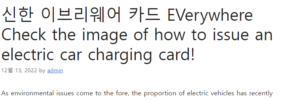As environmental issues come to the fore, the proportion of electric vehicles has recently increased significantly. This is because they do not emit pollutants emitted from vehicles with internal combustion engines, and maintenance costs, such as fuel costs, are low. In particular, as the number of places that operate electric vehicles in many fields, such as vehicles of public institutions, is increasing, there are many cases of renting or renting a vehicle.
So, even if the current vehicle is not necessarily an electric vehicle, it is good for drivers to know how to operate or charge an electric vehicle in preparation for the situation. Today, we will have time to summarize how to charge electric vehicles, how to charge them, and how to issue a card. 신한 이브리웨어 카드

How to charge an electric car?
1. From issuance of charge card 이베이스매뉴얼
Before charging an electric vehicle, you must first obtain a charging card. Electric vehicle charging cards are issued by the Ministry of Environment. If you use a private company or manufacturer’s own card, the charging fee measurement method is different, so the Ministry of Environment card can be convenient for charging anywhere under the same conditions.
First of all, if you access the Ministry of Environment’s zero-emission vehicle integrated website to issue a card, you will go through a self-authentication process after signing up as a member. It is issued simply by entering the type and model name of the vehicle, the vehicle number, the reason for issuance, and the delivery address.
2. Search charging stations
After issuing the card, you should first check if there is a charging station nearby in order to charge it. Usually, a search function for a nearby charging station is provided in the navigation system attached to each vehicle model. Even if you search for an electric vehicle charging station with an application on your mobile device, you can search for a nearby charging station through various applications.
3. Check the charging method
If you visit a charging station to charge, check the charging method. There are two ways to charge electric vehicles: slow and rapid. Slow charging is often referred to as alternating current, and rapid charging is literally expressed as direct current.
Because electric vehicles can be charged using direct current, in the case of slow charging, the battery is charged in the process of converting alternating current to direct current. Because the vehicle is charged by converting alternating current into direct current, it takes about 8 hours to charge 100%.
Conversely, rapid charging does not take long because it is a method of charging the vehicle directly with direct current. Vehicles can be charged within 30 minutes to 1 hour.
4. Charging
Since electric vehicles do not have a gas station like regular vehicles, you can find an electric vehicle charging area in the vehicle, open the cover, and insert the charging cord. If you press the payment method on the charger and make a payment using the issued card, simply plug in the charging cable and charging will begin immediately.
In the case of an electric vehicle, there is no need to turn off the engine while refueling, unlike vehicles with an internal combustion engine, so it can be charged as it is, and even on rainy days, it can be safely charged without the risk of electric shock. When charging is complete, separate it from the charging terminal and clean it up for the next driver to complete charging.
Recharge fee information
Charges for electric vehicle charging methods are set differently depending on the charging speed. If you check the charging speed first, you can charge from 50kw to 350kw. 50kw has a slow charging speed, but 292.2 won/kwh, 100kw and 200kw are rated at 309.1 won/kwh as normal charging speeds and fast charging speeds, respectively.
350kw can be charged in the fastest time among current electric vehicle charging speeds, and the rate is set differently depending on the operator, around 300 won, so please refer to the charging rate of the device. If you calculate the average fuel economy of an electric vehicle around 5 km, it will cost about 60 won to travel 1 km.
So far, I’ve taken the time to organize and find out how to charge electric vehicles, costs, and card issuance methods. Many people install home chargers to charge their electric vehicles. It costs about KRW 4 million including installation cost and machine cost, but it can save charging time and cost.
There are about 260,000 charging stations nationwide, and the number is increasing, so please check the exact charging method and charge the most efficiently.